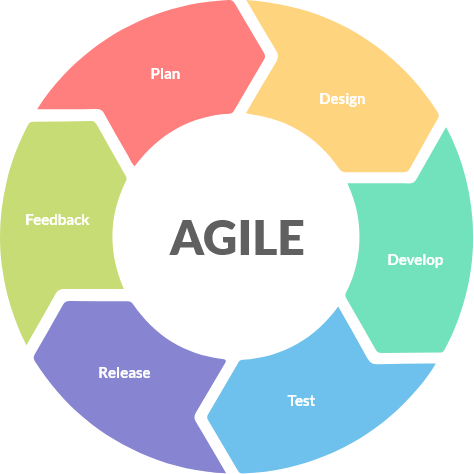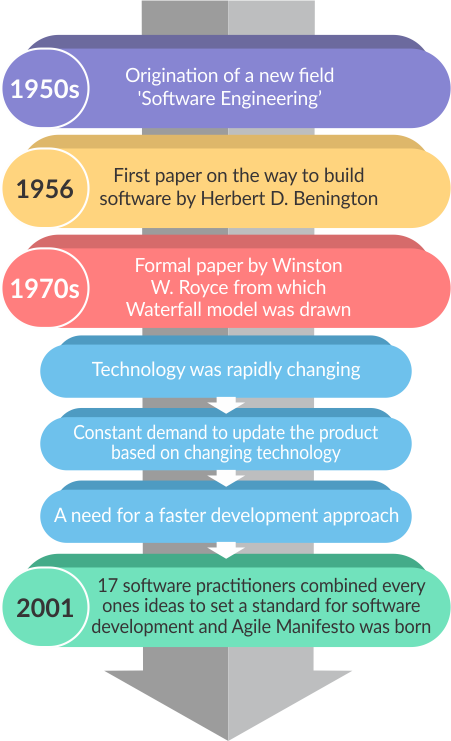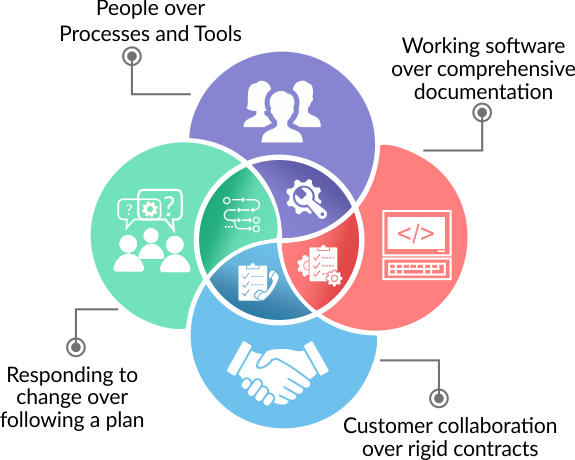Agile Methodology
Agile Methodology
In this comprehensive guide, you’ll learn all about:

What is Agile Methodology?
Agile Methodology is a software development philosophy to build software incrementally by breaking it into several small stages that are aligned with changing business needs. In simpler terms, Agile Methodology is the incremental and iterative way of delivering software.
Agile model altered the long single-pass software development process of 6 to 12 months, where all the requirements and risks are documented upfront to delivering a workable product within a few weeks.
Agile Methodology is the modern form of software development befitting the rapidly changing world by adapting to frequent feedbacks and incorporating continuous iterative improvements.

Evolution of Agile Methodology
Time and again, people have delivered exceptional work in human civilization. And to get work done, they had practices.
Initially, these practices were developed out of the trial and error method. And, later on, became management theories which are still applied in big enterprises.Similarly, in the 1950s, a relatively new field originated, which was coined as Software Engineering as an alias for Software Development. And, in 1956 Herbert D. Benington started writing the first way to build software.
Later in the 1970s, Winston W. Royce wrote a formal paper from which the Waterfall model for software development was mistakenly drawn. And, went on to become the first and most popular software development framework – The Waterfall Methodology.
The waterfall methodology focuses on completing each phase of development before the next phase starts. The waterfall development framework is sequential, prescriptive, and documentation intensive. Though the waterfall model was popular, it was process-heavy and unresponsive to changes.
The software industry realized a need for an alternate approach, mainly because of three primary reasons
- Technology was rapidly changing
- Constant demand to update the product based on changing technology
- A need for a faster development approach
This rapid need for a change in the software industry led 17 software practitioners to come together in 2001 to discuss an alternative software development approach that should address the problems of existing models.
Most of the participants individually had tried out different processes successfully. As each process had its own advantages, they decided on not selecting a better approach or combining their ideas, instead focused on identifying a generic term that describes everyone’s ideas to set a standard for software development.
And thereby the birth of the Agile Manifesto.
What is the Agile Manifesto?
Agile Manifesto describes a collection of tools and best practices that helps in better software development by focusing on efficiency, collaboration, quality, and creation of exceptional customer value.
The Agile Manifesto consists of 4 Values

1. People over processes and tools
Agile Methodology gives low precedence to the adherence of process or use of elaborative tools. It is important to focus on the contributions that each person brings to the team and the trust and communication that exists within the team.
Agile believes that people are more productive when they can talk and work together face to face. Agile Methodology recommends reducing the barriers that inhibit people’s ability to get together.
2. Working software over comprehensive documentation
Software product development is a creative activity that is difficult to envision through the use of static documents entirely. Agile Methodology recommends creating a working code that the customer can try and provide instant feedback rather than exchanging documents such as best plans and product specifications. This helps customers and business users to try the working models before signing off on them.
3. Customer collaboration over rigid contracts
The Agile model believes in intense customer collaborations with the development team. In Agile Methodology, the development team should focus on regular customer interaction for constant feedback and work within the team to adjust the timeline as the project progress.
4. Responding to change over following a plan
Agile understands the fact that the only thing which is certain when a project starts is the constant changes that follow.
The Agile team must quickly adapt to the changes rather than sticking with a plan that was created at the beginning of the project.
Note: Agile values have a deliberate use of the word “over” to emphasize the significance of what is to the left.
The 12 Principles of Agile Software
Agile software development methodologies could be unique and distinct as your team. But it should follow these principles to make decisions in developing your software.
- Prioritize customer satisfaction through early and continuous delivery of software
- Open to frequent changes, even late in development to provide the customer with a competitive advantage
- Frequent delivery of working software in regular intervals, with a preference to the shorter timescale
- Customer and developer should collaboratively work throughout the project
- Support, trust and motivate the team
- Encourage face-to-face conversation within the team
- Working software is the primary measure of progress
- All stakeholders should be able to maintain a constant pace indefinitely
- Continuous attention to technical excellence and good design
- Simplicity
- Self-organizing teams deliver best architectures, requirements, and designs
- Regular team review to become more productive
What is Agile Project Management?
Agile Project Management is the process by which software development projects can be managed and implemented in small chunks of work.
In traditional waterfall methodology, the whole process of development takes a year to complete, and the business will not see any tangible value until the very end.
On the contrary, Agile projects deliver value to the business in frequent small deliveries of products, which are called features.
In Agile Project Management, the features are created in small logical chunks called Iterations or Sprints. The Agile Project Management team has to ensure that “any feature that is going to be built should meet the real-time usage of the customer requirements.”
In short, a successful Agile Project Management characteristics are
- Developing high-quality software which meets the customer’s needs
- Anticipate change & frequent customer feedback
- Plan, design and build the software at a sustainable pace
- Autonomous & cross-functional teams
Note: Apart from the ones mentioned above, Agile Projects should also follow the 4 Core Values and 12 Guiding Principles for adopting an Agile methodology.

What are the steps in the Agile Methodology?
Agile is not a methodology but is a set of values and principles. And to be Agile, the stakeholders can choose between multiple implementation frameworks to deliver the finest quality of software.
Agile project management frameworks like Scrum and Kanban are the most used frameworks, and the two frameworks are more or less very similar in process.
Let’s explore the 6 common steps in the Agile project management frameworks.
1. Project Planning
Like in any other project, an Agile project, too, starts with understanding and planning the client requirement by drafting a minimum feature set. The planning should accommodate flexibility in changing customer needs and customer feedback.
2. Product Roadmap
In order to build a product roadmap, it is essential to break down the features which will make up the final product. The product owner will create a prioritized set of features known as product backlogs, which will go into the product once you start the sprints. This list will evolve in priorities with every sprint.
3. Release Planning
In traditional waterfall methodology, the whole process of development takes a year to complete, post which the implementation kicks off. But in Agile Methodology, the development happens in shorter life cycles called sprints. Each sprint consists of well-planned features and is deployed in a phased manner. In Agile, the product owner prepares a high-level plan for feature releases. And, before each sprint, the product owner will revisit and reassess the feature release plan.
4. Sprint Planning
In this step, the product owner and the stakeholders need to discuss the user requirements and estimate the relative time period to complete the product backlog. It is essential to assess the team’s capabilities, tasks, and share the work smartly to achieve the assigned task in each sprint. Sprint planning builds transparency within the team and helps identify bottlenecks faster and to rectify them.
5. Daily Meeting
A daily stand-up meeting is a short 15 minutes long, which helps understand what the team has completed since the previous meeting, what they are working on, or anything that needs help. Some teams even hold meetings standing to keep it brief and not to be an extending problem-solving session.
6. Sprint Review and Retrospective
Sprint review and retrospective meetings occur at the end of each sprint. First, the sprint review occurs, where the team showcases the finished feature product to the product owner and stakeholders. This helps in open communication and discussion on the feedbacks of the products. And the retrospective meeting is where the team discusses what they can do to improve the process going forward.
Note: If you are new and planning to implement Agile project management, don’t skip the daily meetings and sprint reviews since these are the essential meetings that help you identify and remove bottlenecks.
Transitioning to Agile Project Management
The transition to Agile project management is a slow process. You can’t quickly jump from waterfall to Agile today. Before getting started into Agile Project Management, it is crucial to consider the following.

1. Executive support for Agile Process
The executives who talk about Agile and drive teams towards faster delivery to market often don’t follow the Agile values and principles. The executives need to become more familiar with the Agile development process to work closely with the teams for the better transition and success of the product.
2. Acknowledge the need for Project Management Process
It is crucial to have a project manager and project management process for transitioning to Agile Methodology. Agile teams who embrace the project management process and maintaining the Agile framework have a much better chance of success.
3. Provide Transition Time to be Agile
One of the biggest problems is expecting a brand new “Agile” team to be productive instantly. The Agile team needs time to grow and form. The transition to Agile project management goes through forming, storming, norming, and performing phases.
4. Crawl, Walk, Run
A software development company cannot completely move all their projects into “Agile” right away with “Piloting” first. Leadership teams and project resources have a better percentage of success in transitioning to Agile project management by implementing in smaller and less impactful projects to test and prove it works in your organization before going all out.
5. Foster Training
The Agile development process is not quickly learned off-the-cuff. It requires everyone involved to be trained continuously. If your organization is going to embrace “Agile Methodology,” then ensure that people involved are trained and ready!
Benefits of Agile Project Management
The Agile Project Management helps in achieving these cut-through advantages.
- Accelerating time to market
- Enhancing the ability to manage changing priorities
- Increasing productivity & improved team morale
- Enhancing software quality & reducing risk
- Improving the alignment between business and IT objectives
- Improved engineering discipline & managing distributed team
Get started with Agile
Finally, Agile Methodology is not a one-way road. You will be much more successful if you adapt to your team functioning when following the above fundamental values and principles of Agile project management. Let your team mindset slowly change to Agile ways of process, roles, and principles before accelerating your software development process. After all, Agile is all about people over process. By focusing on people’s efficiency, collaboration, quality, and creation of exceptional customer value on-time, every time. That’s pretty much all on what you need to know for successful Agile project management.
Software Development Help
DO YOU WANT TO CONTROL DIGITALLY?
CONTACT US
